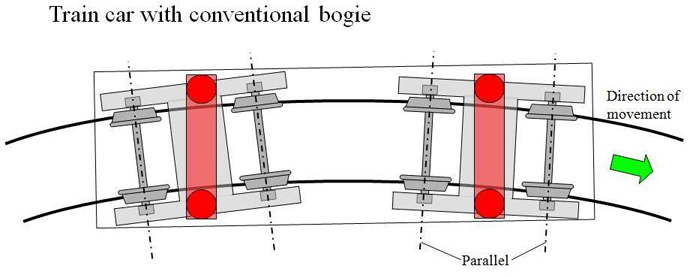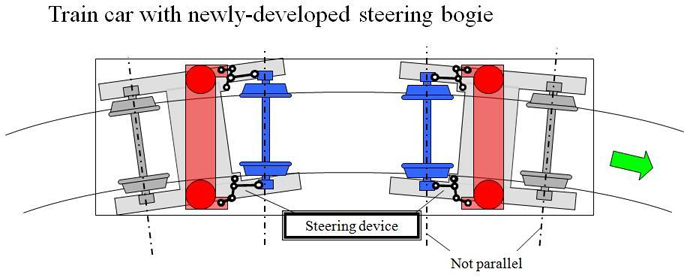2011.02.17
- Sumitomo Metal Industries, Ltd.
- Sumitomo Corporation
Sumitomo Metal Industries, Ltd. (Sumitomo Metals) and Sumitomo Corporation have received an order for 240 bogies (for 120 rail cars) from Tokyo Metro Co., Ltd. The bogies equip the steering devices that have jointly been developed by Sumitomo Metals and Tokyo Metro. Contrary to the conventional bogie with fixed axles, the new steering bogie is designed to allow the axle to self-align with curvature. This enables the bogie to run stably on curved track and reduce noise as well as wear of the wheels. The bogies that have been ordered this time will be used for the new 1000 Series cars of the Ginza Line of Tokyo Metro, and are scheduled to be placed in operation from spring 2012. This will be the first use of the steering bogie for subways in Japan. In addition, this is the largest order ever of steering bogies for railways in Japan.
1. Newly-developed steering bogies
The railway bogie has two sets of axles and wheels and axles are conventionally fixed to the bogie. As the axles remain in parallel on curved track, the wheel rubs against the curved rail and causes a squeal noise.
The steering bogie, on the other hand, has steering device that allows self-steering of axles and wheels, to move in line with the curve when running on curved track. The smooth running enables reduction of the squeal noise. Friction between the flange of the wheel and the rail is also reduced, resulting in extending the service life of the wheel.
Steering bogies have long been researched and developed by many railway research institutions and manufacturers in the world. As the structures have become more complex, commercial use of steering bogies in Japan has so far been limited to some express trains.
Sumitomo Metals have eagerly conducted test operations of steering bogies on a test line at the Osaka Steel Works of Railway, Automotive & Machinery Parts Company and on commercial train lines of Tokyo Metro. The Company has accumulated data and made many improvements. This has resulted in successful development of the new steering bogie that has a relatively simple structure but enables superior performance when running on curved track. Specifically, the steering devices are installed only on the two inner sets of axles and wheels, out of the total of four sets for a train car. (See the diagram below.)
The new steering bogie makes possible almost complete elimination of the squeal noise and roughly doubles the service life of the wheel.
2. Details of order
| |
(1) Product: |
Steering bogies for subway cars |
| |
(2) Quantity: |
240 bogies (for 120 cars of 20 trains) |
| |
(3) Time of delivery: |
From July 2011 |
| |
(4) Start of commercial operation: |
From spring 2012 (Plan) |
3. Future development
Sumitomo Metals and Sumitomo Corp. will work on expanding sales of the newly-developed steering bogies to subway lines that have many sections with tight curves in Japan and abroad.
<Figure>
<Reference> Major bogies developed by Sumitomo Metals
| Technology development |
Name of railway company and railway |
Introduction |
Effects |
|
| |
Teito Rapid Transit Authority |
| |
(present Tokyo Metro) |
| |
Hanzomon Line |
|
|
| |
Weight reduction of the bogie |
|
|
| |
Osaka Municipal Subway |
| |
Nagahori Tsurumi-ryokuchi Line |
|
|
| |
Size reduction of the bogie |
|
|
| |
East Japan Railway Company |
| |
Tohoku Shinkansen |
|
|
| |
Improvement in ride comfort |
|
| |
Car body tilting control by air spring |
|
| |
Nagoya Railroad Co., Ltd.
|
| |
Tokoname Line, Kuko (Airport) Line |
|
|
| |
Higher speed on curved track |
|
| |
Railway running safety monitoring technology |
|
| |
Tokyo Metro
|
| |
Marunouchi Line |
|
|
| |
Constant monitoring of force on the wheels
|
|


